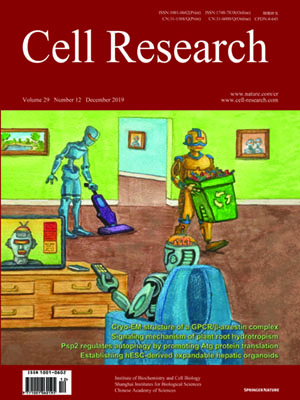
Volume 29, No 12, Dec 2019
ISSN: 1001-0602
EISSN: 1748-7838 2018
impact factor 17.848*
(Clarivate Analytics, 2019)
Volume 29 Issue 12, December 2019: 984-993 | Open Access
ORIGINAL ARTICLES
Asymmetric distribution of cytokinins determines root hydrotropism in Arabidopsis thaliana
Jinke Chang1, Xiaopeng Li1, Weihao Fu1, Jiawen Wang1, Yueyuan Yong1, Hongyong Shi1, Zhaojun Ding 2, Hong Kui1, Xiaoping Gou 1, Kai He1 and Jia Li1
1Ministry of Education Key Laboratory of Cell Activities and Stress Adaptations, School of Life Sciences, Lanzhou University, 730000 Lanzhou, China and 2The Key Laboratory of Plant Development and Environmental Adaptation Biology, Ministry of Education, College of Life Sciences, Shandong University, Qingdao 266237 Shandong, China
Correspondence: Jia Li (lijia@lzu.edu.cn)
The phenomenon of plant root tips sensing moisture gradient in soil and growing towards higher water potential is designated as root hydrotropism, which is critical for plants to survive when water is a limited factor. Molecular mechanisms regulating such a fundamental process, however, are largely unknown. Here we report our identification that cytokinins are key signaling molecules directing root growth orientation in a hydrostimulation (moisture gradient) condition. Lower water potential side of the root tip shows more cytokinin response relative to the higher water potential side. Consequently, two cytokinin downstream type-A response regulators, ARR16 and ARR17, were found to be up-regulated at the lower water potential side, causing increased cell division in the meristem zone, which allows the root to bend towards higher water potential side. Genetic analyses indicated that various cytokinin biosynthesis and signaling mutants, including the arr16 arr17 double mutant, are significantly less responsive to hydrostimulation. Consistently, treatments with chemical inhibitors interfering with either cytokinin biosynthesis or cell division completely abolished root hydrotropic response. Asymmetrically induced expression of ARR16 or ARR17 effectively led to root bending in both wild-type and miz1, a previously known hydrotropism-defective mutant. These data demonstrate that asymmetric cytokinin distribution is a primary determinant governing root hydrotropism.
https://doi.org/10.1038/s41422-019-0239-3
FULL TEXT | PDF
Browse 1208


